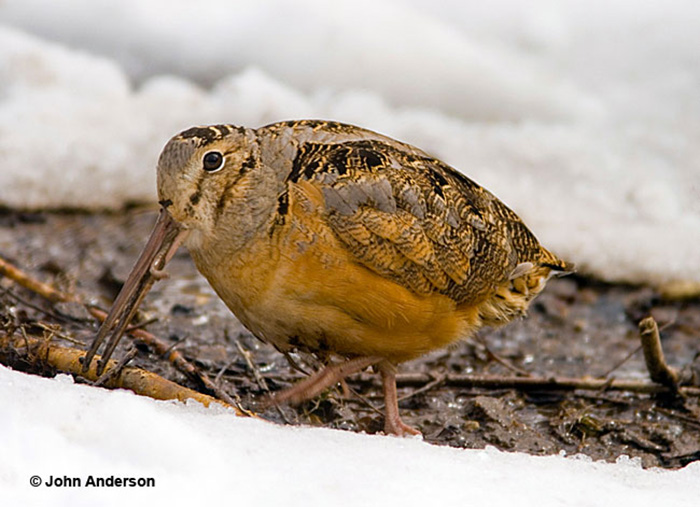American Woodcocks (Scolopax minor) are peculiar medium-sized shorebirds found in moist woodlands and brushy areas across eastern North America.
They are famous for their courtship displays and their unique foraging behaviors, including the little “dance” they do by rocking back and forth. Their peculiarities don’t stop there, though. Let’s find out more about these timberdoodles, shall we?
Identification
The American Woodcock is a medium-sized, bulbous shorebird with a distinctive appearance.
They have a plump, compact body with a short neck, a short tail, a long and straight pinkish bill, and short pinkish legs.
Their brown eyes are located almost at the back of the skull, giving them 360° vision horizontally and 180° vision vertically, which leaves them with no blind spots.
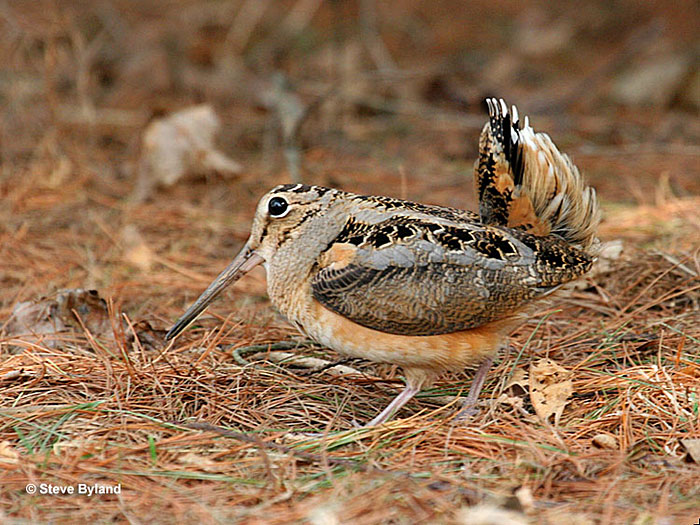
The birds have broad and rounded wings with a wingspan of 16.5-19 inches and their bodies measure about 10 to 12 inches long.
Male and female American Woodcocks look alike, and their only difference is that females are slightly larger than males.
American Woodcock’s overall plumage is mottled and cryptically colored, including shades of browns, grays, and black, providing excellent camouflage in their woodland habitats. On the underside, they are mostly buffy to rust-colored.
Their face is tan, they have a dark cap, and their back and wings are a patchwork of brown, black, and gray spots. Juvenile American Woodcocks resemble adults but have a duller plumage.
Vocalizations
American Woodcock’s sounds and calls are often associated with their courtship displays. The peent call is a nasal, buzzy sound that is repeated several times. Male woodcocks typically produce this call while on the ground during the late afternoon or early evening as part of their courtship ritual in an attempt to attract females.
After the peenting phase, male woodcocks take to the sky in continually widening circles. During this aerial display, the wings create a distinctive twittering sound. This sound is created by the air rushing through the primary feathers of their wings. They then hover for a moment and start chirping melodically while zigzagging back to the ground.
Food
The American Woodcock’s diet primarily consists of invertebrates. Earthworms make up a significant portion of their diet, up to 90% to be specific. The bird uses its long bill to probe into the soil and extract earthworms from their burrows. They have specialized nerves at the tip of their bills that help them detect vibrations created by the movement of worms underground.
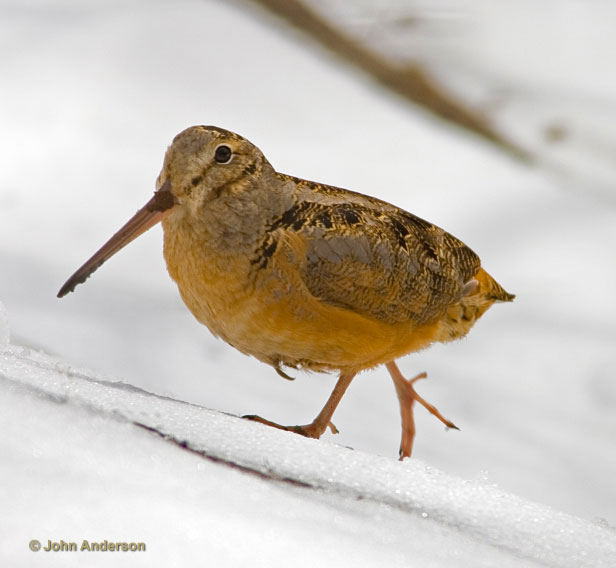
In addition to earthworms, they also feed on a variety of insects, insect larvae, and other invertebrates. This can include beetles, ants, caterpillars, spiders, and other small arthropods. They catch these prey items by pecking or probing in the leaf litter and soft soils.
On occasion, woodcocks may consume small crustaceans and mollusks, particularly in wetland areas.
While the majority of their diet is animal-based, American Woodcocks may also consume small amounts of seeds and plant matter such as sedges, grasses, and smartweeds, especially during the non-breeding season.
This species is most active during dawn and dusk. Their feeding strategy involves walking slowly through soft soils, probing the ground with their bills, and using their sensitive bill tips to detect and capture prey. There is evidence that they stomp their feet or shift their weight (that little back-and-forth dance they do) to get underground prey moving, which they then locate by hearing or by feeling for the vibrations.
Nesting and Eggs
The courtship displays of American Woodcocks typically begin in the late winter or early spring and last for six months. Males try to attract females through a combination of ground displays and aerial acrobatics which we talked about previously. Females choose a male, copulate, and then leave.
After mating, the female finds a suitable nesting site, often in grassy or shrubby areas. The birds are ground nesters, and the nests are well-camouflaged to blend in with the surrounding vegetation.
American Woodcock nest is a simple depression on the ground, lined with leaves and other plant material. Sometimes, there is no nest at all, and the eggs are laid directly on the ground.
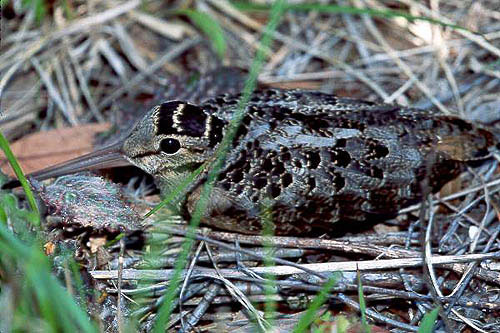
She then lays a clutch of 1-5, mostly 4 eggs. American Woodcock eggs are grayish-orange with dark brown markings. They measure 1.4-1.7 inches long and 1.1-1.2 inches wide.
The mother bird incubates the eggs for 20-22 days. After hatching, the chicks leave the nest within a few hours, along with their mother. She feeds them for the first weeks and broods them until they are about 15-20 days old. The young become independent at around 31 to 38 days of age.
Current Situation
American Woodcock’s range covers most of eastern North America. They are resident in the southeastern United States. Their breeding range extends north to southeast Canada and their wintering range extends south to the tip of Florida and northernmost Mexico.
American Woodcock’s habitats vary slightly depending on the season and what they are doing. Generally speaking, they prefer places with moist soil and brushy areas and are most often found in young forests, forest edges, old fields, brushy swamps, or wet thickets.
For courtship displays, they need a more open space, such as pastures, old fields, or forest openings. On the other hand, females prefer to nest in environments where they can blend in, such as forests, thickets, or shrublands. You can find them foraging in places with moist soil and young trees. In the winter, they inhabit a variety of forest types.
American Woodcocks are listed as of least concern on the IUCN Red List. However, their numbers appear to be in decline due to accidents, habitat loss due to development, hunting, and poisoning due to accumulating pesticides from insects they eat.
Facts
- American Woodcocks are peculiar birds and have an array of even more peculiar names, including bog sucker, night partridge, becasse, timberdoodle, Labrador twister, brush snipe, and hokumpoke.
- American Woodcocks generally live around 8 years. The oldest American Woodcock on record lived to be 11 years and 4 months old.
- The American Woodcock is the slowest-flying bird in the world. They can fly as slow as 5 miles per hour without stalling.
- American Woodcocks may rock their bodies back and forth during foraging and sometimes also flash with their tail. There are two theories on why they do this. The first one is that they are trying to make earthworms move underground so they can locate and eat them. This is the most common explanation. The other theory is that they are notifying potential predators that they are not worth attacking as they are already aware of them.
Similar Species
There are a quite few birds with mottled camouflaging plumage, long bills, and round bodies or at least some of the mentioned characteristics to make identifying them difficult. Here are some of the most similar species to the American Woodcock and ways to tell which one is which.
Wilson’s Snipe
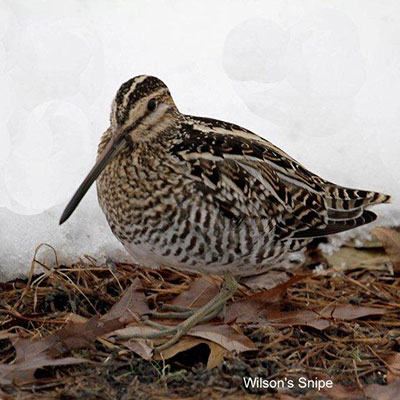
Wilson’s Snipe has an extensive range that covers virtually the whole of North and Central America and extends to northern South America. Instead of forests, they prefer more open areas and are found in all types of marshy and wet settings, such as along rivers and ponds and in swamps and bogs.
Wilson’s Snipe has a slenderer build and narrower wings with a distinctive striped or barred pattern on its back and flanks and a white belly. It has a straight bill that is longer relative to its body size. American Woodcock, on the other hand, has a plumper appearance, a mottled pattern on its back, rust-colored underparts, and a shorter, more flexible bill. Wilson’s Snipe also has longer legs.
Short-billed Dowitcher
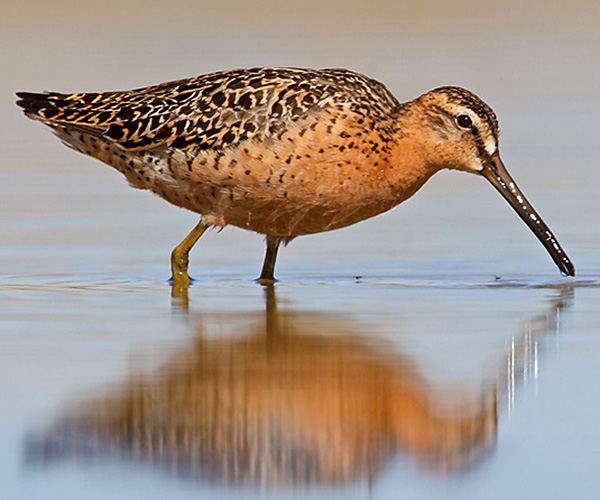
Photograph © Glenn Bartley.
Short-billed Dowitchers can mostly be found along the coasts of North, Central, and South America but also breeds in northern Quebec and north-central Canada. They are primarily found foraging in shallow water in wetland habitats, including mudflats, marshes, and coastal areas.
Short-billed Dowitchers have different breeding and non-breeding plumage, both in camouflaging colors. Their non-breeding plumage features a whitish underside and brownish-gray upperside, head and chest. However, in their breeding plumage, they are mottled brown, cinnamon, and black on the upperside and cinnamon on the underside.
Long-billed Dowitcher
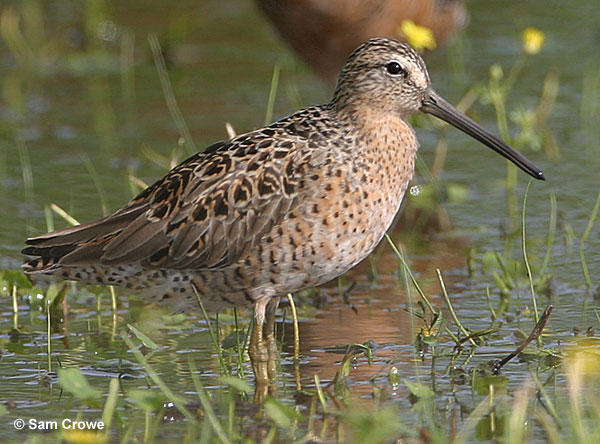
The Long-billed Dowitcher breeds in western and northern Alaska, winters in the southernmost US and Mexico, and can be seen in both western and eastern North America during migration. They are known to forage in shallow water or mud in a variety of wetland habitats, similar to Short-billed Dowitchers.
They also have breeding plumage and nonbreeding plumage. Their nonbreeding plumage is grayish all over with a lighter underside. In their breeding plumage, their upperside and cap are mottled in dark, cold browns, whereas their underside and face are warm cinnamon.
FAQ
Are American Woodcocks rare?
American Woodcocks are not rare, they are rather common.
Where does the American Woodcock live?
The American Woodcock primarily lives in moist woodlands, brushy fields, and areas with soft, damp soils in eastern North America.
Can American Woodcocks fly?
American Woodcocks can fly. In fact, they have beautiful aerial displays during courtship!

